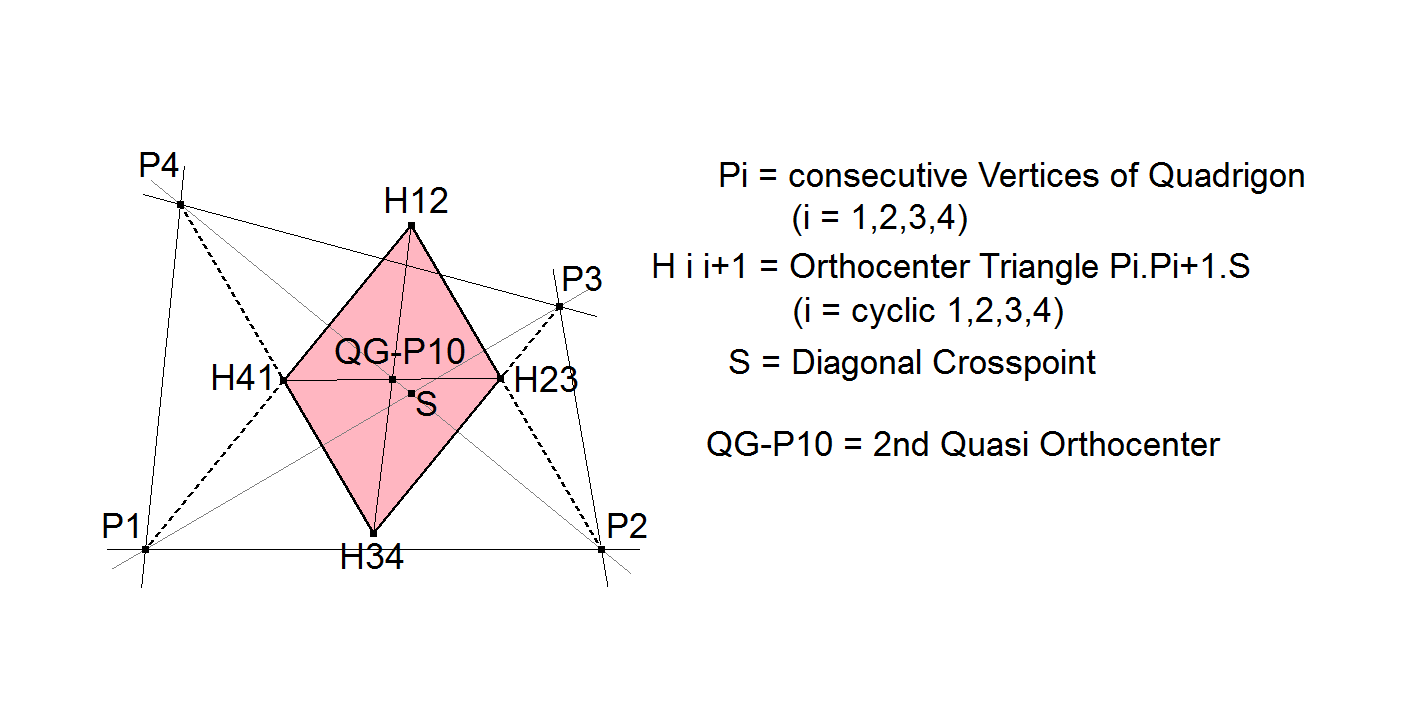QG-P10 2nd Quasi Orthocenter
Let P1.P2.P3.P4 be a Quadrigon and let S be its Diagonal Crosspoint QG-P1.
Let Hi i+1 = Orthocenter of Triangle Pi.Pi+1.S (i = cyclic sequence 1,2,3,4) .
Now is H12.H23.H34.H41 a parallelogram. Remarkable is that each vertex of the Reference Quadrigon lies on a sideline of the parallelogram and that the sides of this parallelogram are perpendicular to the diagonals of the Reference Quadrigon.
QG-P10 is the Center of this parallelogram.

CT-Coordinates QG-P10 in 3 QA-Quadrigons (only coordinates of 1st Quadrigon point are given)
(-a2 (p2 + p q + q r + r2) SA + (c2 p q + a2 p r + c2 p r + a2 q r) SC + 4 (2 p2 + p q + p r + q r + r2) Δ2 :
-b2 (a2 + c2) p r – (a2 – c2) q r SC + SA ((a2 – c2) p q + (p2 + r2) SC) + 8 p r Δ2 :
SA (c2 p q + a2 p r + c2 p r + a2 q r + (p2 + p q + q r) SB) – c2 r2 SC + 4 r (p + 2 r) Δ2 )
CT-Coordinates QG-P10 in 3 QL-Quadrigons (only coordinates of 1st Quadrigon point are given)
(a2 m (b2 l2 + c2 l2 – 2 b2 l m + b2 m2) n – a2 m2 n2 SA – 2 c2 l m2 n SC + SB (-l m (b2 m2 + a2 n2 + b2 n2) + l2 (m2 + n2) SC) – 4 (l – 2 m) m n (2 l – m + n) Δ2 :
b2 (a2 + b2 + c2) l m2 n – b2 l2 n2 SB – m (b2 l2 + c2 l2 + b2 m2) n SC + SA (-l m (b2 m2 + a2 n2 + b2 n2) + m2 (l2 + n2) SC) – 4 l n (l m – 2 l n + m n) Δ2 :
c2 l m (b2 m2 – 2 b2 m n + a2 n2 + b2 n2) – m (b2 l2 + c2 l2 + b2 m2) n SB + SA (-2 a2 l m2 n + (l2 + m2) n2 SB) – c2 l2 m2 SC + 4 l m (2 m – n) (l – m + 2 n) Δ2)
CT-Area of QG-P10-Triangle in the QA-environment (equals 4 * area QA-Morley Triangle)
((a2 q r + b2 p r+ c2 p q)2) / (8 Δ (p + q) (p + r) (q + r) (p + q + r))
CT-Area of QG-P10-Triangle in the QL-environment
0 (because vertices are collinear)
–
DT-Coordinates QG-P10 in 3 QA-Quadrigons (only coordinates of 1st Quadrigon point are given)
(-(Sc (p2-q2-r2)-2 Sb q2) (-c2 p2+a2 r2) :
-Sa2 p2 (p2+q2-r2)+Sc2 r2 (p2-q2-r2)-S2 q2 (p2-q2+r2)-2 Sb q2 (Sa p2+Sc r2) :
(Sa (p2+q2-r2)+2 Sb q2) (c2 p2-a2 r2)}
DT-Coordinates QG-P10 in 3 QL-Quadrigons (only coordinates of 1st Quadrigon point are given)
(Sb m2 (Sb (l2-n2)+Sc (l2-m2)) : Sa a2 l2 m2+Sc c2 m2 n2-Sa Sc m4-S2 l2 n2 : -Sb m2 (Sb (l2-n2)+Sa (m2-n2)))
DT-Area of QG-P10-Triangle in the QA-environment (equals 4 * area QA-Morley Triangle)
-(Sa p2+Sb q2+Sc r2)2 / (2S (-p+q+r) (p+q-r) (p-q+r) (p+q+r))
DT-Area of QG-P10-Triangle in the QL-environment
0 (because vertices are collinear)
Properties
- QG-P8, QG-P9, QG-P10, QG-P11 are collinear on QG-L5, 2nd QG-Quasi Euler Line.
- QG-P10 is the Orthocenter of the 2nd QG-Quasi Diagonal Triangle: QG-Tr2.
- QG-P10 is the Reflection of QG-P5 in QA-P1 (QA-Centroid).
- QG-P10 is the Reflection of QG-P15 in QG-P7.
- QG-P10 is the Midpoint of QG-P1 and QG-P6.
- The three QA-versions of QG-P10 define a circle with center QA-P15 (note Eckart Schmidt).
- The three QA-versions of QG-P10 form a Triangle with centroid QA-P14 (note Eckart Schmidt).
- The three QL-versions of QG-P10 are collinear on the line QL-L6 (Quasi Ortholine).
- QA-P2 (Euler-Poncelet Point) lies on the circumcircle of the triangle formed by the three QA-versions of QG-P10. QA-P15 is the circumcenter.
- The line through the 1st and 2nd Quasi Orthocenters (QG-P6 and QG-P10) is perpendicular to the Newton Line (QL-L1).
- When the Quadrigon is cyclic the Maltitudes concur in QG-P10 (a Maltitude is a line drawn from the midpoint of a side perpendicular to the opposite side of a Quadrigon). This point in a cyclic Quadrigon is also known as the Anticenter.
- Let Hi be the Orthocenters of the Component Triangles Pj.Pk.Pl of the Reference Quadrigon. Now QG-P10 is the Diagonal Crosspoint of the Quadrigon formed by the Midpoints(Pi, Hi) (Eckart Schmidt, September 18, 2012).
- The QG-P10 Triple Triangle in a Quadrangle is Orthologic wrt all QA-Component Triangles. See QA-Tr-1.
Estimated human page views: 584
